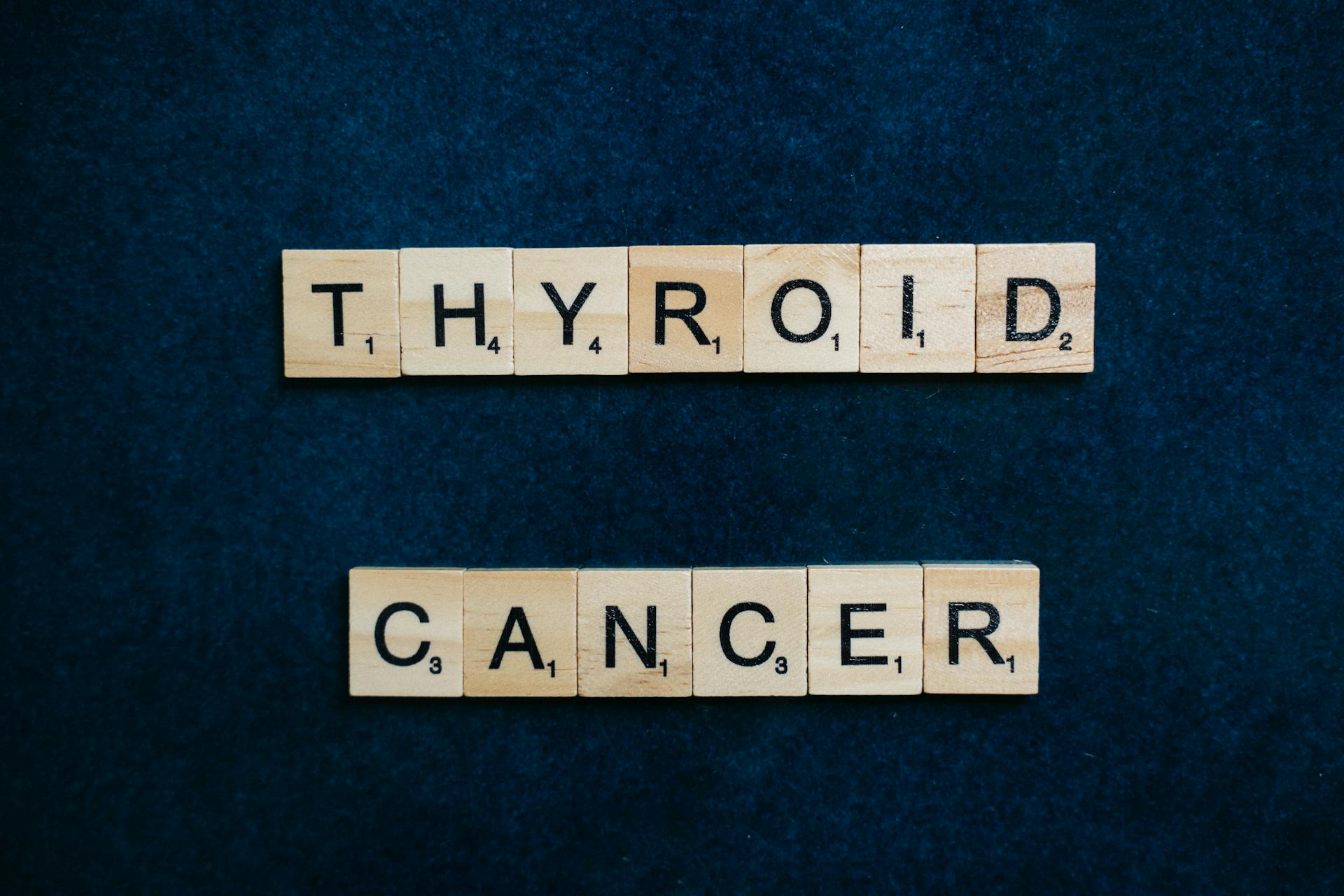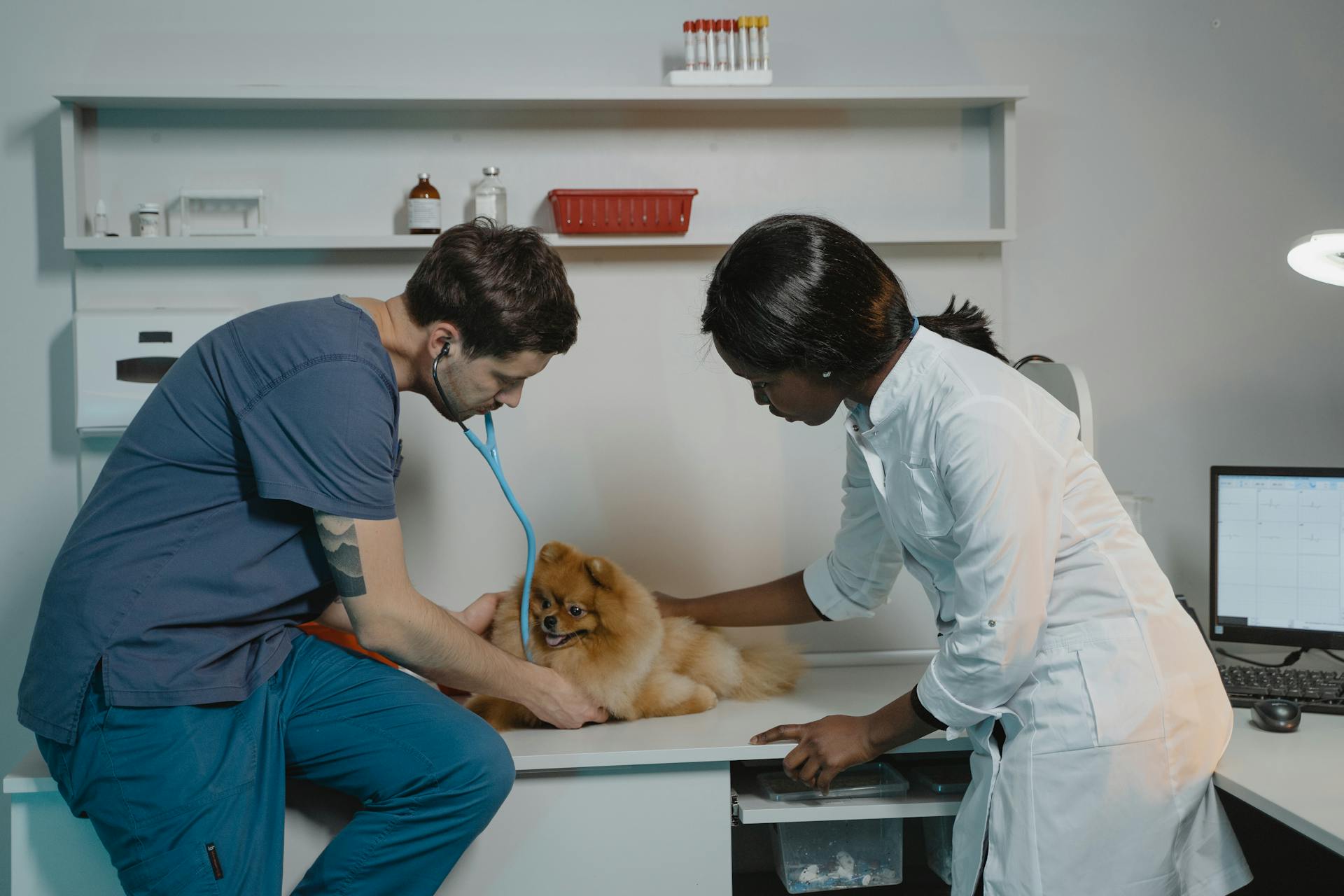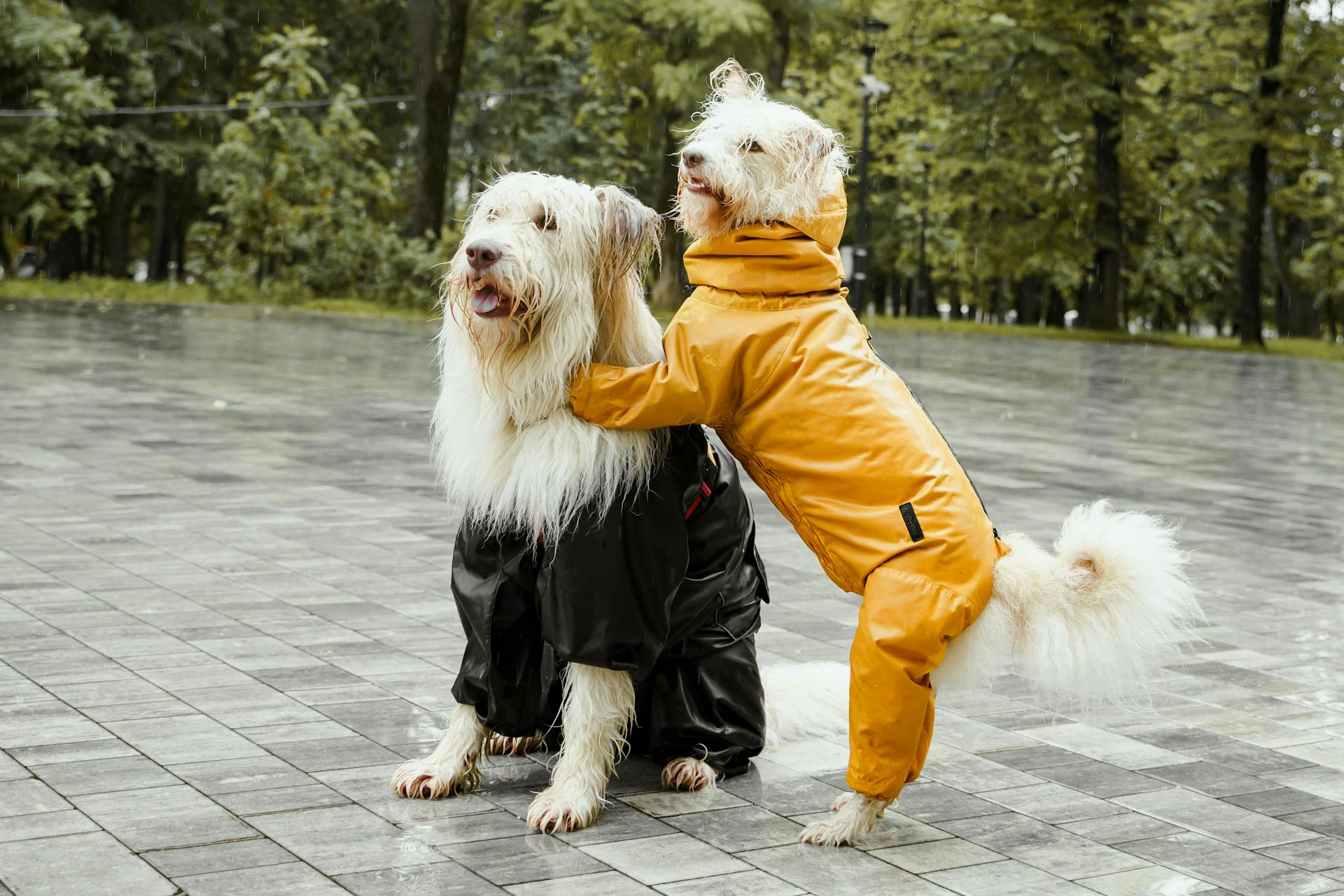
Hypothyroidism in dogs is a common endocrine disorder that affects many breeds. It occurs when the thyroid gland doesn't produce enough thyroid hormones.
The most common symptoms of hypothyroidism in dogs include weight gain, hair loss, and skin problems. These symptoms can be mild or severe, and they can also be similar to those of other health issues.
Some breeds are more prone to hypothyroidism than others, including Cocker Spaniels, Doberman Pinschers, and Golden Retrievers.
What is Hypothyroidism in Dogs?
Hypothyroidism is a common endocrine disease in dogs that results in decreased production of thyroid hormones.
Dogs with hypothyroidism usually have either inflammation of the thyroid glands or degeneration of the glands.
These glands are located on either side of the neck near the throat and are responsible for producing thyroid hormones that serve an important role in metabolism.
If the glands are not producing enough hormones, the dog's body functions slow down.
Thyroid tumors are fairly uncommon in dogs.
Hypothyroidism is most common in middle-aged dogs, with medium-to-large breed dogs being more commonly affected.
Golden Retrievers, Dobermans, Dachshunds, Miniature Schnauzers, Cocker Spaniels, and Irish Setters are among the breeds more predisposed to hypothyroidism.
The thyroid gland is located in the neck and is one of the most important glands in the body because it regulates metabolism.
An underactive thyroid gland doesn't produce enough thyroid hormone, which results in a slowed-down metabolic rate.
If left untreated, hypothyroidism can be life-threatening and potentially affect a dog's heart rate, respiration, core temperature, nervous system, muscle tone, and more.
The thyroid glands produce important hormones that help regulate a dog's metabolism.
Hypothyroidism in dogs results from the body's inability to produce and release sufficient amounts of thyroid hormones.
It's essential to have your dog diagnosed and treated by a veterinarian if you suspect hypothyroidism.
Consider reading: Why Are My Dog's Nails Splitting?
Causes and Risk Factors
Hypothyroidism in dogs is a common condition, especially in middle-aged dogs around 6-7 years old. Most affected dogs are spayed females and neutered males.
The risk of hypothyroidism is higher in certain breeds, including Golden Retrievers, Doberman Pinschers, Beagles, Borzois, Great Danes, Irish Setters, and Old English Sheepdogs. These breeds are more prone to the condition due to genetic predisposition.
Hypothyroidism can be caused by two main factors: lymphocytic thyroiditis, an autoimmune disease where the dog's immune system attacks the thyroid gland, and idiopathic thyroid gland atrophy, where thyroid tissue is replaced by fat tissue. These conditions can be managed with medication, and early detection is key to preventing life-threatening complications.
Here's a breakdown of the two main causes of hypothyroidism:
Possible Causes
Hypothyroidism in dogs is often caused by an immune-mediated attack on the thyroid gland, which can lead to inflammation and scarring that impairs the gland's function.
The two most common causes of hypothyroidism in dogs are lymphocytic thyroiditis and idiopathic thyroid gland atrophy. Lymphocytic thyroiditis occurs when a dog's immune system mistakenly attacks the thyroid gland, while idiopathic thyroid gland atrophy is characterized by the replacement of normal thyroid tissue with fat tissue.
Expand your knowledge: Idiopathic Head Tremor in Dogs

Autoimmune thyroiditis causes hypothyroidism in dogs nearly 90% of the time, making it the most common cause of the condition.
High-risk breeds for hypothyroidism include Golden Retrievers, Doberman Pinschers, Beagles, Borzois, Great Danes, Irish Setters, and Old English Sheepdogs.
These breeds are more prone to developing hypothyroidism due to a genetic predisposition.
The condition is less common in small dogs.
The pituitary gland can also play a role in hypothyroidism, with issues affecting its function resulting in secondary hypothyroidism.
Here are the possible causes of hypothyroidism in dogs:
- Lymphocytic thyroiditis ( autoimmune thyroiditis)
- Idiopathic thyroid gland atrophy
- Secondary hypothyroidism (caused by other illnesses such as thyroid inflammation, thyroid gland shrinkage, and thyroid cancer)
Risk Factors
Most dogs diagnosed with hypothyroidism are middle-aged, around 6-7 years old.
Spayed females and neutered males are at a higher risk of developing hypothyroidism.
A specific location of an inherited predisposition for hypothyroidism has been identified in some dogs through analysis of the canine genome.
Hypothyroidism usually occurs in mid to large-size breed dogs between 4 and 10 years of age.
Early detection is facilitated by routine wellness blood screening for senior pets.
Is it Common?

Hypothyroidism is a common clinical condition in dogs, as stated by veterinarians.
Many breeds are prone to hypothyroidism, including German Shepherds, Golden Retrievers, and Cocker Spaniels.
The condition is more likely to occur in dogs that are overweight or obese, which is a common issue in many pets.
Hypothyroidism is often diagnosed between the ages of 4 to 10 years old, although it can occur at any age.
A common symptom of hypothyroidism is a dull coat, which can be a sign that your dog needs to see a veterinarian.
Symptoms and Diagnosis
Symptoms of hypothyroidism in dogs can be subtle, but they're often noticeable. Weight gain is a common symptom, even if your dog's appetite hasn't changed.
A dog with hypothyroidism may exhibit lethargy and laziness, preferring to sleep and lie around all day rather than run and play. Heat-seeking behavior is also common, as your dog tries to stay warm due to their low metabolism.
Chronic skin and ear infections can be a sign of hypothyroidism, and your dog may experience dry and brittle hair with a thinning hair coat. They may also develop increased pigmentation of the skin or an inability to regrow hair after it's been shaved.
Here are some common symptoms of hypothyroidism in dogs:
- Weight gain despite no change in appetite
- Lethargy and disinterest
- Symmetrical hair loss on the torso and tail tip
- Infections (especially skin and ears)
These symptoms can be wide-ranging and variable, and it's essential to recognize the early signs of hypothyroidism to minimize the severity of the condition.
What Are the Symptoms of?
Dogs with hypothyroidism often show a range of symptoms, which can be divided into two main categories: physical and behavioral.
Weight gain is a common symptom, often occurring without an increase in appetite. Your dog may seem to be gaining weight even though they don't eat that much food.
Lethargy and laziness are also common, with dogs preferring to sleep and lie around all day rather than run and play. They may even seek out heat sources to try and stay warm.
Curious to learn more? Check out: How Often Can You Put Flea Medicine on a Dog

Chronic skin and ear infections are another symptom, which can be a sign of an underlying issue with hypothyroidism. Allergies are relatively common in dogs, but chronic infections may indicate a more serious problem.
Dogs with hypothyroidism may also experience dry and brittle hair, with a thinning hair coat. They may lose hair from their back, sides, or tail, giving it a rat tail appearance.
Some dogs may also develop increased pigmentation of the skin, or be unable to regrow hair after it's been shaved.
Here are some of the most common symptoms of hypothyroidism in dogs:
- Weight gain despite no change in appetite
- Lethargy and disinterest
- Symmetrical hair loss on the torso and tail tip
- Infections (especially skin and ears)
- Dull and brittle coat
- High cholesterol
- Less cold tolerance
- Skin hyperpigmentation (darker areas) and thickening
- Bradyarrhythmia (an abnormally slow resting heart rate)
- Anemia
These symptoms can vary widely from dog to dog, and some may experience neurological difficulties, such as balance problems, numbness, and weakness. Others may develop megaesophagus, which makes it difficult for food to reach the stomach.
Diagnosing
Diagnosing hypothyroidism in dogs involves a combination of physical examination, medical history, and blood tests. Your veterinarian will start with a physical examination and take a thorough medical history, including any unusual behaviors or physical changes you've noticed in your dog.
If this caught your attention, see: Medical Alert Dog Training

A blood test is the primary way to diagnose hypothyroidism. Your vet will draw blood from your dog to test for thyroid hormone levels. Most commonly, this involves a total thyroxine level (Total T4, or TT4) test.
Additional blood tests, such as a free T4 level or a full thyroid panel, may be run to confirm the diagnosis. These tests can help rule out other medical conditions and evaluate your dog's overall health.
Some dogs may have normal or low total T4 levels but still have hypothyroidism. In these cases, additional tests can be especially helpful in confirming the diagnosis.
A low total T4 level is not always a definitive indicator of hypothyroidism. Other factors, such as certain medications or diseases, can also cause low values.
A different take: Intelligence Tests for Dogs
Treatment and Recovery
Hypothyroidism is not curable, but its treatment is straightforward. Treatment for hypothyroidism consists of once- or twice-daily oral administration of a synthetic thyroid hormone.
The initial dose is calculated based on the animal's weight, but ongoing adjustments are necessary. Repeated thyroid profiles are necessary to regulate each dog's individual response for the best outcome.
No notable improvement of symptoms is expected within the first 4 to 8 weeks of hormone replacement treatment. This is a normal part of the recovery process.
Resolution of the clinical signs of hypothyroidism takes a few months, but with regular treatment and monitoring, a dog with hypothyroidism is expected to have a normal, full coat of hair and easily maintain a healthy weight.
Your dog will need to stay on their thyroid replacement hormone for life. This medication is called levothyroxine, and it's a synthetic form of the thyroid hormone your dog is missing.
Untreated hypothyroidism can shorten your dog's life span, as nearly every organ in the body is affected by thyroid hormone and by the metabolism. Dogs with untreated hypothyroidism develop high cholesterol, decreased immune function, a slowed heart rate, and neuromuscular signs.
These neuromuscular signs may include unsteadiness, a head tilt, and even seizures. While hypothyroidism responds well to treatment, untreated hypothyroidism can have a negative effect on your dog's quality of life.
Consider reading: A Guide to Managing Healthy Weight in Your Dog This Summer
Management of hypothyroidism in dogs requires lifelong therapy with oral thyroid hormone replacement. Tolerance of medication may change over time, so your dog may require dose adjustments from time to time.
It's recommended that you have your dog's blood thyroid levels checked every 6-12 months to ensure they are still on the appropriate dose of their medication. This is crucial to prevent too little or too much thyroid hormone.
Once your dog's thyroid levels have been restored to normal, your dog may lose weight as their body condition improves and will likely have more energy. While it can take months for your dog's hair to grow back, they will likely experience an improvement in their skin and hair coat over time.
Hypothyroidism may result in decreased tear production in dogs, so monitor your dog's eyes for any development of green-yellow discharge.
See what others are reading: Boarding Your Dog for the First Time
Frequently Asked Questions
How long can a dog live with hypothyroidism?
With proper management, dogs with hypothyroidism can live a normal life expectancy. Lifelong treatment is required, but most dogs see significant improvement within a few weeks or months
What foods should dogs with hypothyroidism avoid?
Dogs with hypothyroidism should avoid Brassica family vegetables like broccoli, cabbage, and cauliflower, which contain goitrin that can slow thyroid function
What happens if hypothyroidism is left untreated in dogs?
If left untreated, hypothyroidism can lead to serious health issues in dogs, including high cholesterol, weakened immune system, and slowed heart rate. Untreated hypothyroidism can significantly shorten a dog's lifespan and affect nearly every organ in the body.
What foods help hypothyroidism in dogs?
Dogs with hypothyroidism may benefit from small amounts of fresh vegetables like asparagus, green beans, and broccoli, which support thyroid function
Will my dog lose weight on thyroid medication?
Typically, dogs on thyroid medication experience an increase in appetite and weight loss, but noticeable improvements in skin problems and ear infections may take 4-8 weeks
Sources
- https://vetster.com/en/conditions/dog/hypothyroidism-in-dogs
- https://www.petdermatologyclinic.com/hypothyroidism-in-dogs
- https://www.petmd.com/dog/conditions/endocrine/c_dg_hypothyroidism
- https://www.pawlicy.com/blog/hypothyroidism-in-dogs/
- https://www.akc.org/expert-advice/health/hypothyroidism-in-dogs/
Featured Images: pexels.com


